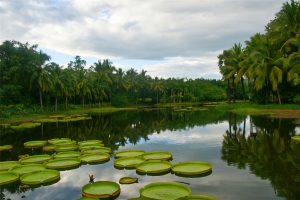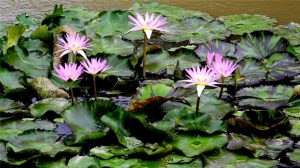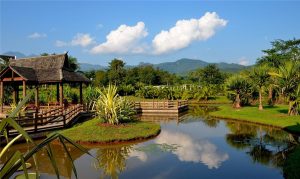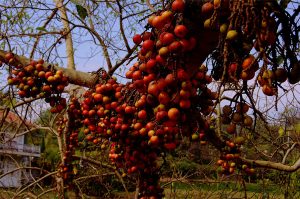
XishuangBanna Tropical Botanical Garden

Chinese Name: 西双版纳热带植物园
Chinese Piyin: Re Dai Zhi Wu Yuan
English Name: Xishuangbanna Tropical Botanical Garden
Type: tropical forest, research institution, botanical garden
Altitude: 570 meters
Best Time: November to April
Recommended Visiting Hours: 4-5 hours
Opening Hours: 8:00a.m.~6:00p.m.
Ticket: CNY 104
Location: Mengla county, Xishuangbanna Dai Autonomous Prefecture, Yunnan Province, China.
Xishuangbanna Tropical Botanical Garden

Xishuangbanna Tropical Plants Garden (Chinese name: 西双版纳热带植物园) was built in 1959, is the biggest and richest botanical garden in China nowadays. Since 1996, this garden combined with former Kunming Ecological Research Institute, formed an independent research institution attached to Chinese Academy of Science. With the time goes by, it becomes a comprehensive garden that combined research, preservation and education of tropical plants together. The main tasks of this garden are exploitation to the resources of tropical plants and bio-diversity conservation. A vast expanse of rainforest has been well preserved in this 900 hectares land. Hundreds of thousands tropical plants from home and abroad are planted separately in 35 specified gardens – Palm Garden, Banyan Tree Garden, Dracaena Draco Garden and Cycas Revoluta Garden, etc.
Why is Xishuangbanna Tropical Botanical Garden so special?
Xishuangbanna Tropical Plants Garden is the biggest and richest botanical garden in China nowadays, which has established relationship with over 50 counties worldwide, and its international influence moves up gradually. Now, it is the National Education Base of Science and the National Tourism Spot.
1.National AAAAA Scenic Spot
2.Research institution attached to Chinese Academy of Science
3.National Education Base of Science
Where is Xishuangbanna Tropical Botanical Garden?
Xishuangbanna Tropical Botanical Garden is located in Menglun Town of Mengla County, Xishuangbanna. It is built on the Gourd Island of Luosuo River, which is the branch of Lancang River.
Distance from nearby cities
96 km from Jinghong City
100 km from urban area of Mengla County
How to Get to Xishuangbanna Tropical Botanical Garden?
Travelers can take the bus to Menglun Town or Mengla County in Jinghong Passengers Station, then get off in Menglun, 16-20 yuan for ticket. It will cost you about 1 hour. After arriving at Menglun Passenger Station, you can get to it after 10-minute walking.
If you departure from Kunming or Puer, you can take the bus to Mengla and take off in Menglun Town.
History

In April of 1958, Tropical Botanical Garden was built in Xiaojie Street of Menglong in Jinghong. Then it was moved to Menglun Town of Mengla County because of public security in the end of 1958. Xishuangbanna Tropical Botanical Garden was established on the Gourd Island formally on January 1st of 1959. It was attached to Kunming Ecological Research Institute. In January of 1978, it was changed to Tropical Botanical Research Institution of Yunnan Province attached to Chinese Academy of Science. It was entitled as National AAAAA Scenic Spot in July of 2011.
Main Attractions
1.National Tree and Flower Garden (国树国花园)
The majority of countries have their own national trees and flowers which are the symbol of a country and the reflection of their value and culture. The 1.3 hectare garden was built in 1999 to celebrate 99 EXPO, the World Horticultural Exposition. There are 55 national trees and flowers from 66 countries, such as Plumeria rubra var. Acutifolia from Laos ans azalea from Belgium. All of them contend in beauty and fascination.
2.Famous People and Trees Garden (名人名树园)
The garden occupies an area of 3.7 hectares and has a collection of 343 tropical plants. There is a statue named as a tour in the forest which reflects the life and work of Professor Cai Xitao and his students. Professor Cai invested his lives and medicine and discovered that the Mayten tree has the function of killing cancer cells and planted it in artificial ways. He also planted a Dracaena which we can get medicine of invigorating the circulation of blood from it. There are also the trees planted by celebrities, the acacia olive whose seed is heart-shaped planted by former president Jiang Zeming, the native olive planted by former premier Li Peng, the tower tree planted by Prince Philip of Britain. The rare plants here are deserve to mention. This is the poison tree, people in the ancient times applied the poison to arrowheads and the one who was shot would die instantly from blood clotting. We can also see the Traveler Trees which looks like a peacock spreading his plumage which grows in deserts and store a lot of water for travelers.

3.Tropical Forest Scenic Area (热带雨林景区)
Tropical Forest Garden has an area of 80 hectares. It is a place for in-situ conservation and removing of plants. There are over 100 kinds of rare and endanger plants. The main scenic area represents the typical feature and plants of the tropical forest, like banyans with board-like root, plants killer, one-tree forest and air corridor etc. It is a comprehensive place of plants collection, conservation, research and education.
4.Rare Flower Garden(奇花异木园)
There are 243 species of rare plants, a lot of them are hardly seen in China. We can taste the mysterious fruit which can turn from sour to sweet. Then, we can appreciate the performance of the dancer–dancing grass. It is sensitive to sound and moved with music. Actually, because the pressure of cells at the tip of the leaves is different from other parts. When there is sound is over 45 decibels nearby, air will vibrant and the pressure of cells will change with the music, so the leaves will move slightly. There is also the shy girl, sensitive grass. When touched, the leaves will drop and shut. There are some liquid bubbles in the stems and they are like bags to store nutrient. When they are touched, liquid will flow out of those bags into leaves. Naturally, leaves will drop and shut due to gravity, after a while, when the bags are refilled, the leaves will recover.
5.Baizhu Garden (Garden of Hundreds of Bamboos) (百竹园)
Baizhu Garden was built in 1965 at first, planting more than 250 kins of bamboos. They are diverse bamboos from south Yunnan, Guangxi, Hainan and southeast Asian.
Nearby Attraction
Wangtianshu Scenic Attraction is the only oasis at 21 degrees north latitude, and has been recognized internationally as China’s unique tropical rainforest. What is the most impressive in the park are the towering Shorea chinensis (Sky Trees) that are the rainforest iconic images in South and Southeast Asia. An Air Corridor (Kong Zhong Zou Lang), 2500 meters long and 36 meters high, has been built on the high canopies. It remains a challenge to both visitors and scientists. The well-protected tropical rainforest that was discovered by the Chinese reputed botanist Mr. Cai Xitao (1911-1981) and witnessed by Prince Philip of the UK, surprised many people when it was unveiled to the outside world. With hotels and air corridor, you can travel and lodge here.
Best Time to Visit Xishuangbanna Tropical Botanical Garden

Belonging to tropical rainforest climate, Xishuangbanna’s dry season is from November to April the next year and rainy season is from May to October. With annual average temperature of 21c, it has long summer and no winter. With cool and pleasant four seasons, the best time for traveling Xishuangbanna is from October to April the next year.
Try to avoid Chinese public holidays, such as Labor Day (May 1st to 3rd) and National Day (October 1st to 7th). It is recommended that you start your day early so as to avoid crowds.
Useful Travel Tips
●Protect the environment, do not pick the flowers, feed the animals and catch the insects.
●Do not smoke in the garden.
●Please park in the suitable place according to the regulars.
●It is better to prepare some mosquito products and sun block in case of insects and sunlight.
●Respect the local customs of Dai and other minorities.













